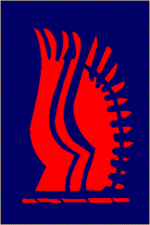Loading AI tools
Military unit From Wikipedia, the free encyclopedia
The 24th Infantry Brigade was an infantry brigade of the British Army from the First World War. It was reraised during the Second World War, as the 24th Infantry Brigade (Guards). During various designations, the brigade was active throughout the Cold War and existed until 1999, when it was merged with the 5 Airborne Brigade to become 16 Air Assault Brigade.
| 24th Brigade 24th Infantry Brigade (Guards) 24th Independent Infantry Brigade Group (Guards) 24th Airportable Brigade 24th (Airmobile) Brigade | |
|---|---|
 Formation badge of the brigade | |
| Active | 1914–1918 1939–1945 1945–1999 |
| Country | |
| Branch | |
| Type | Infantry |
| Size | Brigade |
| Engagements | First World War Second World War |
| Commanders | |
| Notable commanders | Colin Gubbins Frederick Browning Derek Horsford |
The brigade was first formed as part of the 8th Division by battalions returning from overseas stations to reinforce British forces on the Western Front in France. The brigade moved to France with the rest of the 8th Division in November 1914 and fought there for the entire war.
The order of battle included:[1]
The commanders of the 24th Infantry Brigade during the First World War were:[2][3]
The 24th Infantry Brigade (Guards) was formed on 13 February 1940. In April 1940, the brigade was part of the unsuccessful British force sent to fight in the Norwegian Campaign. The brigade arrived in Narvik on 15 April 1940, and was evacuated on 8 June 1940.

In 1942–1943, the brigade formed part of the 1st Infantry Division and the 6th Armoured Division during the Tunisia Campaign. From 7 December 1943 to 31 August 1945, it served in the Italian Campaign with the 1st Infantry Division, and fought at the Battle of Anzio from January to March 1944. By the time the brigade was relieved, it had suffered 1,950 casualties. From March 1944, the brigade supported the 6th South African Armoured Division until March 1945, and then joined the 56th (London) Infantry Division. The brigade helped liberate Trieste in 1945. After the end of the war, the brigade lost its 'Guards' title, and was redesignated as the 24th Independent Infantry Brigade. The brigade formed the infantry element of the Trieste Garrison - BETFOR (British Element Trieste Force).
The following officers commanded the brigade during the war:
The brigade was withdrawn from Trieste in October 1954. It later moved to Kenya. In 1960, as the 24th Infantry Brigade Group, the brigade's commander, Brigadier D.G. Horsford, was rushed from Kenya to Kuwait to take command of the British land forces assembled to dissuade President Kassem of Iraq from invading the country (Operation Vantage). On 12 December 1963 Kenya gained its independence. While 1st Battalion, Gordon Highlanders at Gilgil, were in the process of relocating to Redford Barracks Colinton, Edinburgh, having sent their advance party ahead, trouble started to brew in the newly-independent East African armies.[5] Thus 24th Brigade was reduced to two battalions: 2nd Battalion, Scots Guards and 1st Battalion, Staffordshire Regiment, both at Kahawa, plus 3rd Regiment, Royal Horse Artillery and the remnants of the Gordons when the alerts started coming. The brigade was involved in putting the indigenous army mutinies which sprang up in Zanzibar, Tanzania, in the Uganda Army, and Kenya itself in January 1964. Brigade Headquarters left Kenya for Aden at the end of October 1964, and stayed there until the final British evacuation of Aden in November 1967. On its return home it joined 3rd Infantry Division in 1968 as part of Army Strategic Command and was based at Crownhill Fort in Plymouth.[6]
The brigade arrived in Northern Ireland at the start of The Troubles in mid-1969 and was back again in June 1970. The brigade was soon afterward reorganised as the 24th Airportable Brigade at Streatlam Camp, Barnard Castle, County Durham. At this time the brigade headquarters consisted of elements from various units.[7]
The brigade became the only Regular brigade in the reorganized 2nd Infantry Division, stationed in the north, after the army reorganization which implemented the findings of John Nott's 1981 Defence White Paper. Later that decade, after the successful trial conversion of 6th Armoured Brigade to 6th Airmobile Brigade, it was decided to change over 24th Brigade into a permanent airmobile anti-tank formation.[8] Its war role became the rapid barring and blocking of any Soviet breakthrough of I (BR) Corps defences in Germany. In 1990 several Members of Parliament described the brigade as "no more mobile than a bicycle battalion", due to a lack of available helicopters.[9]
1st Battalion the Royal Anglian Regiment pioneered this new airmobile role and served with UNPROFOR in Bosnia and Herzegovina in 1995, as part of the 'Rapid Reaction Force'.[10]
Under the 1998 Strategic Defence Review, as a cost cutting measure, the brigade was merged with elements of 5th Airborne Brigade to become the new 16th Air Assault Brigade.[10]
In addition to the above structure, on mobilisation the Tactical Support Element, 170 Provost Company, Royal Military Police (under HQ RMP, United Kingdom Land Forces) would have reinforced the brigade.[23]
Seamless Wikipedia browsing. On steroids.
Every time you click a link to Wikipedia, Wiktionary or Wikiquote in your browser's search results, it will show the modern Wikiwand interface.
Wikiwand extension is a five stars, simple, with minimum permission required to keep your browsing private, safe and transparent.